A New Methodology for the Development of Efficient Multistep Methods for First-Order IVPs with Oscillating Solutions
Abstract
1. Introduction
- Exponentially fitted, trigonometrically fitted, phase-fitted and amplification-fitted Runge–Kutta and Runge–Kutta–Nyström methods and Runge–Kutta and Runge–Kutta–Nyström methods with minimal phase lag (see [20,21,22,23,24,25,26,27,28,29,30,31,32,33,34,35,36,37,38,39,40,41,42,43,44,45,46,47,48,49,50,51,52,53,54,55,56,57]).
- Exponentially fitted and trigonometrically fitted phase-fitted and amplification-fitted multistep methods and multistep methods with minimal phase lag (see [58,59,60,61,62,63,64,65,66,67,68,69,70,71,72,73,74,75,76,77,78,79,80,81,82,83,84,85,86,87,88,89,90,91,92,93,94,95,96,97,98,99,100,101,102,103,104,105,106,107,108,109,110,111,112,113,114,115,116,117,118,119,120,121]).
- In Section 2, we develop the general theory for the calculation of the phase lag and amplification error (or amplification factor) of the multistep methods for first-order IVPs.
- In Section 3, we present methodologies for the achievement of the phase lag, amplification factor, phase-fitted, and amplification-fitted multistep methods. More specifically, we present methodologies for the achievement of minimal phase lag of the multistep method, a methodology for the achievement of the amplification-fitted multistep method, and a methodology for the achievement of the phase-fitted and amplification-fitted multistep method.
- In Section 4, we present the stability analysis for the new proposed methods.
- In Section 5, we present the numerical results.
2. The Theory
- The Real Part
- The Imaginary Part
3. Methodologies for Achievement of the Phase Lag, Amplification Factor, Phase-Fitted and Amplification-Fitted Methods
3.1. Classical Methods—Methods with Constant Coefficients Known in the Literature
3.2. Minimal Phase Lag
3.2.1. Algorithm for the Minimization of the Phase Lag
- Elimination of the amplification factor.
- Computation of the phase lag based on the coefficient obtained by the previous step.
- Taylor series expansion of the phase lag computed above.
- Determination of the system of equations in order to achieve minimal phase lag.
- Computation of the new coefficients.
3.2.2. First Method with Minimal Phase Lag (Method with Minimal Phase Lag and Eliminated Amplification Factor with Third Algebraic Order)
3.2.3. Second Method with Minimal Phase Lag (Method with Minimal Phase Lag and Eliminated Amplification Factor with Second Algebraic Order)
- Elimination of the Amplification Factor
- Using the direct formula for the computation of the amplification factor (21) for , we obtain the relation (28).
- Requiring the elimination of the amplification factor for , i.e., requiring , we obtain the relation (29).
- Using the direct formula for the computation of the phase lag (19) with the value of calculated by (29), we obtain:whereand declares the phase lag.
- Taking the Taylor series expansion of the formula (37), we obtain:where
- Requesting the minimization of the phase lag, we obtain the following system of equations:
- Solving the above system of Equation (41), we obtain:
3.3. Amplification Fitted Method
3.4. Phase Fitted and Amplification Fitted Method
4. Stability Analysis
5. Numerical Results
5.1. Problem of Stiefel and Bettis
- The classical Adams–Bashforth method of the third order, which is mentioned as Comp. Meth. I.
- The classical Adams–Bashforth method of the fifth order, which is mentioned as Comp. Meth. II.
- The Runge–Kutta Dormand and Prince fourth-order method [54], which is mentioned as Comp. Meth. III.
- The Runge–Kutta Dormand and Prince fifth-order method [54], which is mentioned as Comp. Meth. IV.
- The Runge–Kutta Fehlberg fourth-order method [123], which is mentioned as Comp. Meth. V.
- The Runge–Kutta Fehlberg fifth-order method [123], which is mentioned as Comp. Meth. VI.
- The Runge–Kutta Cash and Karp fifth-order method [124], which is mentioned as Comp. Meth. VII.
- The Adams–Bashforth method with minimal phase lag (1st Case) which is developed in Section 3.2.2, which is mentioned as Comp. Meth. VIII.
- The Adams–Bashforth method with minimal phase lag (2nd Case) which is developed in Section 3.2.3, which is mentioned as Comp. Meth. IX.
- The Adams–Bashforth amplification fitted method which is developed in Section 3.3, which is mentioned as Comp. Meth. X.
- The Adams–Bashforth phase-fitted and amplification-fitted method, which is developed in Section 3.4, which is mentioned as Comp. Meth. XI.
- Comp. Meth. I, Comp. Meth. VIII, and Comp. Meth. X give approximately the same results
- Comp. Meth. IV gives more accurate results than the Comp. Meth. I, Comp. Meth. VIII, and Comp. Meth. X methods.
- Comp. Meth. VII gives more accurate results than the Comp. Meth. IV method.
- Comp. Meth. II gives more accurate results than the Comp. Meth. VII method.
- Comp. Meth. V gives more accurate results than the Comp. Meth. II method.
- Comp. Meth. VI gives more accurate results than the Comp. Meth. V method.
- Comp. Meth. III gives better results than the Comp. Meth. VI method for the most step sizes, but for small step sizes, it gives approximately the same results as Comp. Meth. VI.
- Comp. Meth. IX gives mixed results. For big step sizes, it gives better results than Comp. Meth. III. For middle step sizes, it gives better results than Comp. Meth. VII but worse results than Comp. Meth. III, Comp. Meth. V, and Comp. Meth. VI. For small step sizes, it gives better results than Comp. Meth. IV but worse results than Comp. Meth. VII.
- Finally, Comp. Meth. XI, gives the most accurate results.
5.2. Problem of Franco et al. [125]
- Comp. Meth. I, Comp. Meth. VIII, and Comp. Meth. X give approximately the same results
- Comp. Meth. II gives more accurate results than the Comp. Meth. I, Comp. Meth. VIII, and Comp. Meth. X methods.
- Comp. Meth. IV gives more accurate results than the Comp. Meth. II method.
- Comp. Meth. V gives more accurate results than the Comp. Meth. IV method.
- Comp. Meth. VII gives more accurate results than the Comp. Meth. V method.
- Comp. Meth. III gives more accurate results than the Comp. Meth. VII method.
- Comp. Meth. VI gives results with the same accuracy as the Comp. Meth. III method.
- Comp. Meth. IX gives better results than the Comp. Meth. VI and Comp. Meth. III methods.
- Finally, Comp. Meth. XI gives the most accurate results.
5.3. Problem of Franco and Palacios [126]
- Comp. Meth. I, Comp. Meth. VIII, and Comp. Meth. X give approximately the same results.
- Comp. Meth. IV gives more accurate results than the Comp. Meth. I, Comp. Meth. VIII, and Comp. Meth. X methods.
- Comp. Meth. II gives more accurate results than the Comp. Meth. IV method.
- Comp. Meth. V gives more accurate results than the Comp. Meth. II method.
- Comp. Meth. VII gives more accurate results than the Comp. Meth. V method.
- Comp. Meth. III gives more accurate results than the Comp. Meth. VII method.
- Comp. Meth. VI gives results with the same accuracy as the Comp. Meth. III method.
- Comp. Meth. IX gives better results than the Comp. Meth. VI and Comp. Meth. III methods.
- Finally, Comp. Meth. XI gives the most accurate results.
5.4. A Nonlinear Orbital Problem [127]
- Comp. Meth. I, Comp. Meth. VIII, and Comp. Meth. X give approximately the same results.
- Comp. Meth. II gives more accurate results than the Comp. Meth. I, Comp. Meth. VIII, and Comp. Meth. X methods.
- Comp. Meth. IV gives more accurate results than the Comp. Meth. II method.
- Comp. Meth. V gives more accurate results than the Comp. Meth. IV method.
- Comp. Meth. VII gives more accurate results than the Comp. Meth. V method.
- Comp. Meth. VI gives results with the same accuracy as the Comp. Meth. VII method.
- Comp. Meth. III gives more accurate results than the Comp. Meth. VI method.
- Comp. Meth. IX gives better results than the Comp. Meth. VI and Comp. Meth. III method.
- Finally, Comp. Meth. XI gives the most accurate results.
5.5. Nonlinear Problem of Petzold [128]
- Comp. Meth. I, Comp. Meth. VIII, and Comp. Meth. X give approximately the same results.
- Comp. Meth. IV gives more accurate results than the Comp. Meth. I, Comp. Meth. VIII, and Comp. Meth. X methods.
- Comp. Meth. II gives more accurate results than the Comp. Meth. IV method.
- Comp. Meth. V gives more accurate results than the Comp. Meth. II method.
- Comp. Meth. VII gives more accurate results than the Comp. Meth. V method.
- Comp. Meth. VI gives results with the same accuracy as the Comp. Meth. VII method.
- Comp. Meth. III gives more accurate results than the Comp. Meth. VI method.
- Comp. Meth. IX gives mixed results. For big step sizes, it gives better results than Comp. Meth. III. For middle step sizes, it gives better results than Comp. Meth. VII but worse results than Comp. Meth. III and Comp. Meth. VI. For small step sizes, it gives better results than Comp. Meth. IV and Comp. Meth. V but worse results than Comp. Meth. VII.
- Finally, Comp. Meth. XI gives the most accurate results.
5.6. Two-Body Gravitational Problem
- Comp. Meth. I, Comp. Meth. VIII, and Comp. Meth. X are not convergent to the solution.
- Comp. Meth. II gives more accurate results than the Comp. Meth. VII method.
- Comp. Meth. VI gives more accurate results than the Comp. Meth. II method.
- Comp. Meth. V gives more accurate results than the Comp. Meth. VI method.
- Comp. Meth. III gives more accurate results than the Comp. Meth. V method.
- Comp. Meth. IX gives results with the same accuracy as the Comp. Meth. III method.
- Comp. Meth. IV gives results with approximately the same accuracy as the results given by the Comp. Meth. IX method.
- Finally, Comp. Meth. XI gives the most accurate results.
5.7. Perturbed Two-Body Gravitational Problem
5.7.1. Case
- Comp. Meth. I, Comp. Meth. VIII, and Comp. Meth. X are not convergent to the solution.
- Comp. Meth. VI gives more accurate results than the Comp. Meth. VII method.
- Comp. Meth. V gives more accurate results than the Comp. Meth. VI method.
- Comp. Meth. III gives more accurate results than the Comp. Meth. V method.
- Comp. Meth. II gives more accurate results than the Comp. Meth. III method.
- Comp. Meth. IV gives more accurate results than the Comp. Meth. II method.
- Comp. Meth. IX gives more accurate results than the Comp. Meth. IV method.
- Finally, Comp. Meth. XI gives the most accurate results.
5.7.2. Case
- Comp. Meth. I, Comp. Meth. VIII, and Comp. Meth. X are not convergent to the solution.
- Comp. Meth. V gives more accurate results than the Comp. Meth. VII method.
- Comp. Meth. VI gives more accurate results than the Comp. Meth. V method.
- Comp. Meth. III gives more accurate results than the Comp. Meth. VI method.
- Comp. Meth. II gives more accurate results than the Comp. Meth. III method.
- Comp. Meth. IV gives more accurate results than the Comp. Meth. II method.
- Comp. Meth. IX gives more accurate results than the Comp. Meth. IV method.
- Finally, Comp. Meth. XI gives the most accurate results.
- The phase-fitted and amplification-fitted methods (Comp. Meth. XI) give the most efficient results for all the problems.
- The Adams–Bashforth method with minimal phase lag (1st Case) (Comp. Meth. VIII) and the Adams–Bashforth amplification-fitted method (Comp. Meth. X) give approximately the same results as the classical Adams–Bashforth method of the third order (Comp. Meth. I).
- The Adams–Bashforth method with minimal phase lag (2nd Case) (Comp. Meth. IX) gives the second most efficient results for most of the problems.
- The methodology which emphasizes the minimization of the phase lag (ignoring the algebraic order of the method), which is developed in Section 3.2.3;
- The methodology which emphasizes on the vanishing of the phase lag and the amplification error of the method, which is developed in Section 3.4.
6. Conclusions
- Methodology for the minimization of the phase lag.
- Methodology for the development of an amplification-fitted method.
- Methodology for the development of a phase-fitted method.
Funding
Data Availability Statement
Conflicts of Interest
Appendix A
Appendix B
Appendix C
- Let us examine the case for the relation (15):which is valid (see Lemma 1).
- Let us consider the relations (15) to be valid for , i.e., let us consider that the relations:are valid.
- We will prove that the relation (15) is valid for . For , we have:Taking into account the following:
- –
- (see (A10))
- –
- (see (13)
- –
- (see (A14))
- –
- (see (14))
the relation (A11) becomes:
- Let us examine the case for the relation (16):which is valid (see Lemma 2).
- Let us consider that relation (16) is valid for , i.e., let us consider that the relation:is valid
- we will prove that relation (16) is valid for . For , we have:We take into account the following:
- –
- (see (A14))
- –
- (see (13)
- –
- (see (A10))
- –
- (see (14))
and relation (A15) becomes:
References
- Landau, L.D.; Lifshitz, F.M. Quantum Mechanics; Pergamon: New York, NY, USA, 1965. [Google Scholar]
- Prigogine, I.; Rice, S. (Eds.) Advances in Chemical Physics Vol. 93: New Methods in Computational Quantum Mechanics; John Wiley & Sons: Hoboken, NJ, USA, 1997. [Google Scholar]
- Simos, T.E. Numerical Solution of Ordinary Differential Equations with Periodical Solution. Doctoral Dissertation, National Technical University of Athens, Athens, Greece, 1990. (In Greek). [Google Scholar]
- Raptis, A.D. Exponential multistep methods for ordinary differential equations. Bull. Greek Math. Soc. 1984, 25, 113–126. [Google Scholar]
- Thomas, R.M.; Simos, T.E. A family of hybrid exponentially fitted predictor-corrector methods for the numerical integration of the radial Schrodinger equation. J. Comput. Appl. Math. 1997, 87, 215–226. [Google Scholar] [CrossRef][Green Version]
- Vigo-Aguiar, J.; Ferrandiz, J.M. A general procedure for the adaptation of multistep algorithms to the integration of oscillatory problems. SIAM J. Numer. Anal. 1998, 35, 1684–1708. [Google Scholar] [CrossRef]
- Vigo-Aguiar, J. Mathematical Methods for the Numerical Propagation of Satellite Orbits. Doctoral Dissertation, University of Valladolid, Valladolid, Spain, 1993. (In Spanish). [Google Scholar]
- Ixaru, L.G. Numerical Methods for Differential Equations and Applications, aus der Reihe: Mathematics and Its Applications; D. Reidel Publishing Company: Dordrecht, The Netherlands; Boston, MA, USA; Lancaster, PA, USA, 1984. [Google Scholar]
- Avdelas, G.; Simos, T.E. Dissipative high phase-lag order Numerov-type methods for the numerical solution of the Schrödinger equation. Phys. Rev. 2000, 62, 1375–1381. [Google Scholar] [CrossRef] [PubMed]
- Quinlan, G.D.; Tremaine, S. Symmetric multistep methods for the numerical integration of planetary orbits. Astron. J. 1990, 100, 1694–1700. [Google Scholar] [CrossRef]
- Avdelas, G.; Simos, T.E. Embedded methods for the numerical solution of the Schrödinger equation. Comput. Math. Appl. 1996, 31, 85–102. [Google Scholar] [CrossRef]
- Avdelas, G.; Simos, T.E. A generator of high-order embedded P-stable method for the numerical solution of the Schrödinger equation. J. Comput. Appl. Math. 1996, 72, 345–358. [Google Scholar] [CrossRef]
- Simos, T.E. Predictor-corrector phase-fitted methods for y′′ = f(x,y) and an application to the Schrödinger equation. Int. J. Quantum Chem. 1995, 53, 473–483. [Google Scholar] [CrossRef]
- Lyche, T. Chebyshevian multistep methods for ordinary differential equations. Numer. Math. 1972, 10, 65–75. [Google Scholar] [CrossRef]
- Raptis, A.D.; Allison, A.C. Exponential—fitting methods for the numerical solution of the Schrödinger equation. Comput. Phys. Commun. 1978, 14, 1–5. [Google Scholar] [CrossRef]
- Simos, T.E. An eighth order exponentially-fitted method for the numerical solution of the Schrödinger equation. Int. J. Mod. Phys. 1998, 9, 271–288. [Google Scholar] [CrossRef]
- Konguetsof, A.; Simos, T.E. On the construction of Exponentially-Fitted Methods for the Numerical Solution of the Schrödinger Equation. J. Comput. Meth. Sci. Eng. 2001, 1, 143–165. [Google Scholar] [CrossRef]
- Hinchliffe, A.; Simos, T.E. Atomic structure computations. In Chemical Modelling: Applications and Theory; The Royal Society of Chemistry: Cambridge, UK, 2000; pp. 38–142. [Google Scholar]
- Simos, T.E.; Vigo-Aguiar, J. On the construction of efficient methods for second order IVPs with oscillating solution. Int. J. Mod. Phys. 2001, 10, 1453–1476. [Google Scholar] [CrossRef]
- Dormand, J.R.; El-Mikkawy, M.E.A.; Prince, P.J. Families of Runge-Kutta-Nyström formulae. IMA J. Numer. Anal. 1987, 7, 235–250. [Google Scholar] [CrossRef]
- Vyver, H.V.D. A Symplectic Exponentially Fitted Modified Runge-Kutta-Nyström Method for the Numerical Integration of Orbital Problems. New Astron. 2005, 10, 261–269. [Google Scholar] [CrossRef]
- Vyver, H.V.D. On the Generation of P-Stable Exponentially Fitted Runge-Kutta-Nyström Methods By Exponentially Fitted Runge-Kutta Methods. J. Comput. Appl. Math. 2006, 188, 309–318. [Google Scholar] [CrossRef]
- Franco, J.M.; Khiar, Y.; Rández, L. Two new embedded pairs of explicit Runge-Kutta Methods adapted to the numerical solution of oscillatory problems. Appl. Math. Comput. 2015, 252, 45–57. [Google Scholar] [CrossRef]
- Franco, J.M.; Gomez, I. Symplectic explicit Methods of Runge-Kutta-Nyström type for solving perturbed oscillators. J. Comput. Appl. Math. 2014, 260, 482–493. [Google Scholar] [CrossRef]
- Franco, J.M.; Gomez, I. Some procedures for the construction of high-order exponentially fitted Runge-Kutta-Nyström Methods of explicit type. Comput. Phys. Commun. 2013, 184, 1310–1321. [Google Scholar] [CrossRef]
- Calvo, M.; Franco, J.M.; Montijano, J.I.; Rández, L. On some new low storage implementations of time advancing Runge-Kutta Methods. J. Comput. Appl. Math. 2012, 236, 3665–3675. [Google Scholar] [CrossRef]
- Calvo, M.; Franco, J.M.; Montijano, J.I.; Rández, L. Symmetric and symplectic exponentially fitted Runge-Kutta Methods of high order. Comput. Phys. Commun. 2010, 181, 2044–2056. [Google Scholar] [CrossRef]
- Calvo, M.; Franco, J.M.; Montijano, J.I.; Rández, L. On high order symmetric and symplectic trigonometrically fitted Runge-Kutta Methods with an even number of stages. BIT Numer. Math. 2010, 50, 3–21. [Google Scholar] [CrossRef]
- Franco, J.M.; Gomez, I. Accuracy and linear Stability of RKN Methods for solving second-order stiff problems. Appl. Numer. Math. 2009, 59, 959–975. [Google Scholar] [CrossRef]
- Calvo, M.; Franco, J.M.; Montijano, J.I.; Rández, L. Sixth-order symmetric and symplectic exponentially fitted Runge-Kutta Methods of the Gauss type. J. Comput. Appl. Math. 2009, 223, 387–398. [Google Scholar] [CrossRef]
- Calvo, M.; Franco, J.M.; Montijano, J.I.; Rández, L. Structure preservation of exponentially fitted Runge-Kutta Methods. J. Comput. Appl. Math. 2008, 218, 421–434. [Google Scholar] [CrossRef]
- Calvo, M.; Franco, J.M.; Montijano, J.I.; Rández, L. Sixth-order symmetric and symplectic exponentially fitted modified Runge-Kutta Methods of Gauss type. Comput. Phys. Commun. 2008, 178, 732–744. [Google Scholar] [CrossRef]
- Franco, J.M. Exponentially fitted symplectic integrators of RKN type for solving oscillatory problems. Comput. Phys. Commun. 2007, 177, 479–492. [Google Scholar] [CrossRef]
- Franco, J.M. New Methods for oscillatory systems based on ARKN Methods. Appl. Numer. Math. 2006, 56, 1040–1053. [Google Scholar] [CrossRef]
- Franco, J.M. Runge-Kutta-Nyström Methods adapted to the numerical integration of perturbed oscillators. Comput. Phys. Commun. 2002, 147, 770–787. [Google Scholar] [CrossRef]
- Franco, J.M. Stability of explicit ARKN Methods for perturbed oscillators. J. Comput. Appl. Math. 2005, 173, 389–396. [Google Scholar] [CrossRef]
- Wu, X.Y.; You, X.; Li, J.Y. Note on derivation of order conditions for ARKN Methods for perturbed oscillators. Comput. Phys. Commun. 2009, 180, 1545–1549. [Google Scholar] [CrossRef]
- Tocino, A.; Vigo-Aguiar, J. Symplectic conditions for exponential fitting Runge-Kutta-Nyström Methods. Math. Comput. Model. 2005, 42, 873–876. [Google Scholar] [CrossRef]
- de Vyver, H.V. Comparison of some special optimized fourth-order Runge-Kutta Methods for the numerical solution of the Schrödinger equation. Comput. Phys. Commun. 2005, 166, 109–122. [Google Scholar] [CrossRef]
- de Vyver, H.V. Frequency evaluation for exponentially fitted Runge-Kutta Methods. J. Comput. Appl. Math. 2005, 184, 442–463. [Google Scholar] [CrossRef]
- Vigo-Aguiar, J.; Martín-Vaquero, J.; Ramos, H. Exponential fitting BDF-Runge-Kutta Algorithms. Comput. Phys. Commun. 2008, 178, 15–34. [Google Scholar] [CrossRef]
- Demba, M.A.; Senu, N.; Ramos, H.; Kumam, P.; Watthayu, W. A Phase– and Amplification–Fitted 5(4) Diagonally Implicit Runge–Kutta–Nyström Pair for Oscillatory Systems. Bull. Iran. Math. Soc. 2023, 49, 24. [Google Scholar] [CrossRef]
- Demba, M.A.; Ramos, H.; Watthayu, W.; Ahmed, I. A New Phase- and Amplification-Fitted Sixth-Order Explicit RKN Method to Solve Oscillating Systems. Thai J. Math. 2023, 21, 219–236. [Google Scholar]
- Monovasilis, T.; Kalogiratou, Z. High Order Two-Derivative Runge-Kutta Methods with Optimized Dispersion and Dissipation Error. Mathematics 2021, 9, 232. [Google Scholar] [CrossRef]
- Ahmad, N.A.; Senu, N.; Ibrahim, Z.B.; Othman, M.; Ismail, Z. Higher Order Three Derivative Runge–Kutta Method with Phase–Fitting and Amplification–Fitting Technique for Periodic IVPs. Malays. J. Math. Sci. 2020, 14, 403–418. [Google Scholar]
- Lee, K.; Alias, M.A.; Senu, N.; Ahmadian, A. On efficient frequency-dependent parameters of explicit two-derivative improved Runge-Kutta-Nystr|"rom method with application to two-body problem. Alex. Eng. J. 2023, 72, 605–620. [Google Scholar] [CrossRef]
- Chien, L.K.; Senu, N.; Ahmadian, A.; Ibrahim, S.N.I. Efficient Frequency-Dependent Coefficients of Explicit Improved Two-Derivative Runge-Kutta Type Methods for Solving Third- Order IVPs. Pertanika J. Sci. Technol. 2023, 31, 843–873. [Google Scholar] [CrossRef]
- Demba, M.A.; Ramos, H.; Kumam, P.; Watthayu, W.; Senu, N.; Ahmed, I. A trigonometrically adapted 6(4) explicit Runge-Kutta-Nyström pair to solve oscillating systems. Math. Methods Appl. Sci. 2023, 46, 560–578. [Google Scholar] [CrossRef]
- Chen, B.Z.; Zhai, W.J. Optimal three-stage implicit exponentially-fitted RKN methods for solving second-order ODEs. Calcolo 2022, 59, 14. [Google Scholar] [CrossRef]
- Senu, N.; Ahmad, N.A.; Othman, M.; Ibrahim, Z.B. Numerical study for periodical delay differential equations using Runge-Kutta with trigonometric interpolation. Comput. Appl. Math. 2022, 41, 25. [Google Scholar] [CrossRef]
- Zhai, W.J.; Fu, S.H.; Zhou, T.C.; Xiu, C. Exponentially-fitted and trigonometrically-fitted implicit RKN methods for solving y” = f (t, y). J. Appl. Math. Comput. 2022, 68, 1449–1466. [Google Scholar] [CrossRef]
- Senu, N.; Lee, K.C.; Ismail, W.F.W.; Ahmadian, A.; Ibrahim, S.N.I.; Laham, M. Improved Runge-Kutta Method with Trigonometrically-Fitting Technique for Solving Oscillatory Problem. Malays. J. Math. Sci. 2021, 15, 253–266. [Google Scholar]
- Fang, Y.L.; Yang, Y.P.; You, X. An explicit trigonometrically fitted Runge-Kutta method for stiff and oscillatory problems with two frequencies. Int. J. Comput. Math. 2020, 97, 85–94. [Google Scholar] [CrossRef]
- Dormand, J.R.; Prince, P.J. A family of embedded Runge-Kutta formulae. J. Comput. Appl. Math. 1980, 6, 19–26. [Google Scholar] [CrossRef]
- Franco, J.M. Runge-Kutta methods adapted to the numerical integration of oscillatory problems. Appl. Numer. Math. 2004, 50, 427–443. [Google Scholar] [CrossRef]
- Franco, J.M. A 5(3) pair of explicit ARKN methods for the numerical integration of perturbed oscillators. J. Comput. Appl. Math. 2003, 161, 283–293. [Google Scholar] [CrossRef]
- Kalogiratou, Z.; Monovasilis, T.; Psihoyios, G.; Simos, T.E. Runge–Kutta type methods with special properties for the numerical integration of ordinary differential equations. Phys. Rep. 2014, 536, 75–146. [Google Scholar] [CrossRef]
- Anastassi, Z.A.; Simos, T.E. Numerical multistep methods for the efficient solution of quantum mechanics and related problems. Phys. Rep. 2009, 482–483, 1–240. [Google Scholar] [CrossRef]
- Chawla, M.M.; Rao, P.S. A Noumerov-Type Method with Minimal Phase-Lag for the Integration of 2nd Order Periodic Initial-Value Problems. J. Comput. Appl. Math. 1984, 11, 277–281. [Google Scholar] [CrossRef]
- Simos, T.E.; Williams, P.S. A Finite Difference Method for the numerical solution of the Schrödinger equation. J. Comput. Appl. Math. 1997, 79, 189–205. [Google Scholar] [CrossRef]
- Thomas, R.M. Phase properties of high order, almost P-stable formulae. BIT Numer. Math. 1984, 24, 225–238. [Google Scholar] [CrossRef]
- Chawla, M.M.; Rao, P.S.; Neta, B. 2-Step 4Th-Order P-Stable Methods with Phase-Lag of Order 6 for Y′′ = F(T,Y). J. Comput. Appl. Math. 1986, 16, 233–236. [Google Scholar] [CrossRef]
- Chawla, M.M.; Rao, P.S. An Explicit 6Th-Order Method with Phase-Lag of Order 8 for Y′′ = F(T, Y). J. Comput. Appl. Math. 1987, 17, 365–368. [Google Scholar] [CrossRef]
- Coleman, J.P. Numerical-Methods for Y′′ = F(X,Y) Via Rational-Approximations for the Cosine. Ima J. Numer. Anal. 1989, 9, 145–165. [Google Scholar] [CrossRef]
- Coleman, J.P.; Ixaru, L.G. P-Stability and Exponential-Fitting Methods for Y′′ = F(X, Y). IMA J. Numer. Anal. 1996, 16, 179–199. [Google Scholar] [CrossRef]
- Coleman, J.P.; Duxbury, S.C. Mixed Collocation Methods for Y′′ = F(X,Y). J. Comput. Appl. Math. 2000, 126, 47–75. [Google Scholar] [CrossRef]
- Ixaru, L.G.; Berceanu, S. Coleman Method Maximally Adapted to the Schrödinger-Equation. Comput. Phys. Commun. 1987, 44, 11–20. [Google Scholar] [CrossRef]
- Ixaru, L.G.; Rizea, M. Numerov Method Maximally Adapted to the Schrödinger-Equation. J. Comput. Phys. 1987, 73, 306–324. [Google Scholar] [CrossRef]
- Ixaru, L.G.; Berghe, G.V.; Meyer, H.D.; Daele, M.V. Four-Step Exponential-Fitted Methods for Nonlinear Physical Problems. Comput. Phys. Commun. 1997, 100, 56–70. [Google Scholar] [CrossRef]
- Ixaru, L.G.; Rizea, M. Four Step Methods for Y′′ = F(X,Y). J. Comput. Appl. Math. 1997, 79, 87–99. [Google Scholar] [CrossRef]
- Daele, M.V.; Berghe, G.V.; Meyer, H.D.; Ixaru, L.G. Exponential-Fitted Four-Step Methods for Y′′ = F(X,Y). Int. J. Comput. Math. 1998, 66, 299–309. [Google Scholar] [CrossRef]
- Ixaru, L.G.; Paternoster, B. A Conditionally P-Stable Fourth-Order Exponential-Fitting Method for Y′′ = F(X, Y). J. Comput. Appl. Math. 1999, 106, 87–98. [Google Scholar] [CrossRef]
- Ixaru, L.G. Numerical operations on oscillatory functions. Comput. Chem. 2001, 25, 39–53. [Google Scholar] [CrossRef] [PubMed]
- Ixaru, L.G.; Berghe, G.V.; Meyer, H.D. Exponentially Fitted Variable Two-Step BDF Algorithm for First Order Odes. Comput. Phys. Commun. 2003, 150, 116–128. [Google Scholar] [CrossRef]
- Ixaru, L.G.; Rizea, M. Comparison of some four-Step Methods for the numerical solution of the Schrödinger equation. Comput. Phys. Commun. 1985, 38, 329–337. [Google Scholar] [CrossRef]
- Ixaru, L.G.; Rizea, M. A Numerov-like scheme for the numerical solution of the Schrödinger equation in the deep continuum spectrum of energies. Comput. Phys. Commun. 1980, 19, 23–27. [Google Scholar] [CrossRef]
- Chawla, M.M.; Rao, P.S. A Noumerov-type Method with minimal phase-lag for the integration of second order periodic initial-value problems II Explicit Method. J. Comput. Appl. Math. 1986, 15, 329–337. [Google Scholar] [CrossRef]
- Rizea, M. Exponential fitting Method for the time-dependent Schrödinger equation. J. Math. Chem. 2010, 48, 55–65. [Google Scholar] [CrossRef]
- Ixaru, L.G.; Rizea, M.; Berghe, G.V.; Meyer, H.D. Weights of the Exponential Fitting Multistep Algorithms for First-Order Odes. J. Comput. Appl. Math. 2001, 132, 83–93. [Google Scholar] [CrossRef]
- Raptis, A.D.; Cash, J.R. Exponential and Bessel Fitting Methods for the Numerical-Solution of the Schrödinger-Equation. Comput. Phys. Commun. 1987, 44, 95–103. [Google Scholar] [CrossRef]
- Raptis, A.D. Exponentially-Fitted Solutions of the Eigenvalue Shrödinger Equation with Automatic Error Control. Comput. Phys. Commun. 1983, 28, 427–431. [Google Scholar] [CrossRef]
- Raptis, A.D. 2-Step Methods for the Numerical-Solution of the Schrödinger-Equation. Comput. Phys. Commun. 1982, 28, 373–378. [Google Scholar] [CrossRef]
- Raptis, A.D. On the Numerical-Solution of the Schrödinger-Equation. Comput. Phys. Commun. 1981, 24, 1–4. [Google Scholar] [CrossRef]
- Raptis, A.D. Exponential-Fitting Methods for the Numerical-Integration of the 4Th-Order Differential-Equation Yiv + F·Y = G. Computing 1980, 24, 241–250. [Google Scholar] [CrossRef]
- Van Daele, M.; Van den Berghe, G. P-stable exponentially-fitted Obrechkoff Methods of arbitrary order for second-order differential equations. Numer. Algorithms 2007, 46, 333–350. [Google Scholar] [CrossRef]
- Fang, Y.; Wu, X. A Trigonometrically Fitted Explicit Numerov-Type Method for Second-Order Initial Value Problems with Oscillating Solutions. Appl. Numer. Math. 2008, 58, 341–351. [Google Scholar] [CrossRef]
- Berghe, G.V.; Daele, M.V. Exponentially-fitted Obrechkoff Methods for second-order differential equations. Appl. Numer. Math. 2009, 59, 815–829. [Google Scholar] [CrossRef]
- Hollevoet, D.; Daele, M.V.; Berghe, G.V. The Optimal Exponentially-Fitted Numerov Method for Solving Two-Point Boundary Value Problems. J. Comput. Appl. Math. 2009, 230, 260–269. [Google Scholar] [CrossRef]
- Franco, J.M.; Rández, L. Explicit exponentially fitted two-Step hybrid Methods of high order for second-order oscillatory IVPs. Appl. Math. Comput. 2016, 273, 493–505. [Google Scholar] [CrossRef]
- Franco, J.M.; Gomez, I.; Rández, L. Optimization of explicit two-Step hybrid Methods for solving orbital and oscillatory problems. Comput. Phys. Commun. 2014, 185, 2527–2537. [Google Scholar] [CrossRef]
- Franco, J.M.; Gomez, I. Trigonometrically fitted nonlinear two-Step Methods for solving second order oscillatory IVPs. Appl. Math. Comput. 2014, 232, 643–657. [Google Scholar] [CrossRef]
- Konguetsof, A. A generator of families of two-Step numerical Methods with free parameters and minimal phase-lag. J. Math. Chem. 2017, 55, 1808–1832. [Google Scholar] [CrossRef]
- Konguetsof, A. A hybrid Method with phase-lag and derivatives equal to zero for the numerical integration of the Schrödinger equation. J. Math. Chem. 2011, 49, 1330–1356. [Google Scholar] [CrossRef]
- de Vyver, H.V. A phase-fitted and amplification-fitted explicit two-Step hybrid Method for second-order periodic initial value problems. Int. J. Mod. Phys. 2006, 17, 663–675. [Google Scholar] [CrossRef]
- de Vyver, H.V. An explicit Numerov-type Method for second-order differential equations with oscillating solutions. Comput. Math. Appl. 2007, 53, 1339–1348. [Google Scholar] [CrossRef]
- Fang, Y.; Wu, X. A trigonometrically fitted explicit hybrid Method for the numerical integration of orbital problems. Appl. Math. Comput. 2007, 189, 178–185. [Google Scholar] [CrossRef]
- de Vyver, H.V. Phase-fitted and amplification-fitted two-Step hybrid Methods for y′′ = f (x, y). J. Comput. Appl. Math. 2007, 209, 33–53. [Google Scholar] [CrossRef]
- de Vyver, H.V. Efficient one-Step Methods for the Schrödinger equation. Match-Commun. Math. Comput. Chem. 2008, 60, 711–732. [Google Scholar]
- Martín-Vaquero, J.; Vigo-Aguiar, J. Exponential fitted Gauss, Radau and Lobatto Methods of low order. Numer. Algorithms 2008, 48, 327–346. [Google Scholar]
- Konguetsof, A. A new two-Step hybrid Method for the numerical solution of the Schrödinger equation. J. Math. Chem. 2010, 47, 871–890. [Google Scholar] [CrossRef]
- Fatheah, A. Hendi, P-Stable Higher Derivative Methods with Minimal Phase-Lag for Solving Second Order Differential Equations. J. Appl. Math. 2011, 2011, 407151. [Google Scholar]
- Wang, Z.; Zhao, D.; Dai, Y.; Wu, D. An improved trigonometrically fitted P-stable Obrechkoff Method for periodic initial-value problems. Proc. R. Soc. Math. Phys. Eng. Sci. 2005, 461, 1639–1658. [Google Scholar] [CrossRef]
- Daele, M.V.; Berghe, G.V.; Meyer, H.D. Properties and Implementation of R-Adams Methods Based On Mixed-Type Interpolation. Comput. Math. Appl. 1995, 30, 37–54. [Google Scholar] [CrossRef]
- Wang, Z. Trigonometrically-fitted Method with the Fourier frequency spectrum for undamped Duffing equation. Comput. Phys. Commun. 2006, 174, 109–118. [Google Scholar] [CrossRef]
- Wang, Z. Trigonometrically-fitted Method for a periodic initial value problem with two frequencies. Comput. Phys. Commun. 2006, 175, 241–249. [Google Scholar] [CrossRef]
- Tang, C.; Yan, H.; Zhang, H.; Li, W. The various order explicit multistep exponential fitting for systems of ordinary differential equations. J. Comput. Appl. Math. 2004, 169, 171–182. [Google Scholar] [CrossRef]
- Tang, C.; Yan, H.; Zhang, H.; Chen, Z.; Liu, M.; Zhang, G. The arbitrary order implicit multistep schemes of exponential fitting and their applications. J. Comput. Appl. Math. 2005, 173, 155–168. [Google Scholar] [CrossRef]
- Coleman, J.P.; Ixaru, L.G. Truncation Errors in exponential fitting for oscillatory problems. Siam J. Numer. Anal. 2006, 44, 1441–1465. [Google Scholar] [CrossRef]
- Paternoster, B. Present state-of-the-art in exponential fitting. A contribution dedicated to Liviu Ixaru on his 70th birthday. Comput. Phys. Commun. 2012, 183, 2499–2512. [Google Scholar] [CrossRef]
- Wang, C.; Wang, Z. A P-stable eighteenth-order six-Step Method for periodic initial value problems. Int. J. Mod. Phys. 2007, 18, 419–431. [Google Scholar] [CrossRef]
- Wang, Z. Obrechkoff one-Step Method fitted with Fourier spectrum for undamped Duffing equation. Comput. Phys. Commun. 2006, 175, 692–699. [Google Scholar] [CrossRef]
- Raptis, A.D.; Simos, T.E. A four-step phase-fitted method for the numerical integration of second order initial-value problems. BIT Numer. Math. 1991, 31, 160–168. [Google Scholar] [CrossRef]
- Shokri, A.; Khalsaraei, M.M. A new family of explicit linear two-step singularly P-stable Obrechkoff methods for the numerical solution of second-order IVPs. Appl. Math. Comput. 2020, 376, 125116. [Google Scholar] [CrossRef]
- Abdulganiy, R.I.; Ramos, H.; Okunuga, S.A.; Majid, Z.A. A trigonometrically fitted intra-step block Falkner method for the direct integration of second-order delay differential equations with oscillatory solutions. Afr. Mat. 2023, 34, 36. [Google Scholar] [CrossRef]
- Salih, M.M.; Ismail, F. Trigonometrically-Fitted Fifth Order Four-Step Predictor-Corrector Method for Solving Linear Ordinary Differential Equations with Oscillatory Solutions. Malays. J. Math. Sci. 2022, 16, 739–748. [Google Scholar] [CrossRef]
- Godwin, O.J.; Adewale, O.S.; Otuwatomi, O.P. An efficient block solver of trigonometrically fitted method for stiff odes. Adv. Differ. Equ. Control Process. 2022, 28, 73–98. [Google Scholar] [CrossRef]
- Lee, K.C.; Senu, N.; Ahmadian, A.; Ibrahim, S.N.I. High-order exponentially fitted and trigonometrically fitted explicit two-derivative Runge-Kutta-type methods for solving third-order oscillatory problems. Math. Sci. 2022, 16, 281–297. [Google Scholar] [CrossRef]
- Obaidat, S.; Butt, R. A new implicit symmetric method of sixth algebraic order with vanished phase-lag and its first derivative for solving Schrodinger’s equation. Open Math. 2021, 19, 225–237. [Google Scholar] [CrossRef]
- Shokri, A.; Neta, B.; Khalsaraei, M.M.; Rashidi, M.M.; Mohammad-Sedighi, H. A Singularly P-Stable Multi-Derivative Predictor Method for the Numerical Solution of Second-Order Ordinary Differential Equations. Mathematics 2021, 9, 806. [Google Scholar] [CrossRef]
- Fang, Y.L.; Huang, T.; You, X.; Zheng, J.; Wang, B. Two-frequency trigonometrically-fitted and symmetric linear multi-step methods for second-order oscillators. J. Comput. Appl. Math. 2021, 392, 113312. [Google Scholar] [CrossRef]
- Chun, C.; Neta, B. Trigonometrically-Fitted Methods: A Review. Mathematics 2019, 7, 1197. [Google Scholar] [CrossRef]
- Stiefel, E.; Bettis, D.G. Stabilization of Cowell’s method. Numer. Math. 1969, 13, 154–175. [Google Scholar] [CrossRef]
- Erwin Fehlberg, Classical Fifth-, Sixth-, Seventh-, and Eighth-Order Runge-Kutta Formulas with Stepsize Control. NASA Technical Report 287. 1968. Available online: https://ntrs.nasa.gov/api/citations/19680027281/downloads/19680027281.pdf (accessed on 3 February 2024).
- Cash, J.R.; Karp, A.H. A variable order Runge–Kutta method for initial value problems with rapidly varying right-hand sides. ACM Trans. Math. Softw. 1990, 16, 201–222. [Google Scholar] [CrossRef]
- Franco, J.; Gómez, I.; Rández, L. Four-stage symplectic and P–stable SDIRKN methods with dispersion of high order. Numer. Algorithms 2001, 26, 347–363. [Google Scholar] [CrossRef]
- Franco, J.M.; Palacios, M. High-order P-stable multistep methods. J. Comput. Appl. Math. 1990, 30, 1–10. [Google Scholar] [CrossRef]
- Simos, T.E. New Open Modified Newton Cotes Type Formulae as Multilayer Symplectic Integrators. Appl. Math. Model. 2013, 37, 1983–1991. [Google Scholar] [CrossRef]
- Petzold, L.R. An efficient numerical method for highly oscillatory ordinary differential equations. SIAM J. Numer. Anal. 1981, 18, 455–479. [Google Scholar] [CrossRef]
- Ramos, H.; Vigo-Aguiar, J. On the frequency choice in trigonometrically fitted methods. Appl. Math. Lett. 2010, 23, 1378–1381. [Google Scholar] [CrossRef]
- Ixaru, L.G.; Berghe, G.V.; Meyer, H.D. Frequency evaluation in exponential fitting multistep algorithms for ODEs. J. Comput. Appl. Math. 2002, 140, 423–434. [Google Scholar] [CrossRef]
- Boyce, W.E.; DiPrima, R.C.; Meade, D.B. Elementary Differential Equations and Boundary Value Problems, 11th ed.; John Wiley & Sons: Hoboken, NJ, USA, 2017. [Google Scholar]
- Evans, L.C. Partial Differential Equations, 2nd ed.American Mathematical Society: Providence, RI, USA, 2010; Chapter 3; pp. 91–135. [Google Scholar]
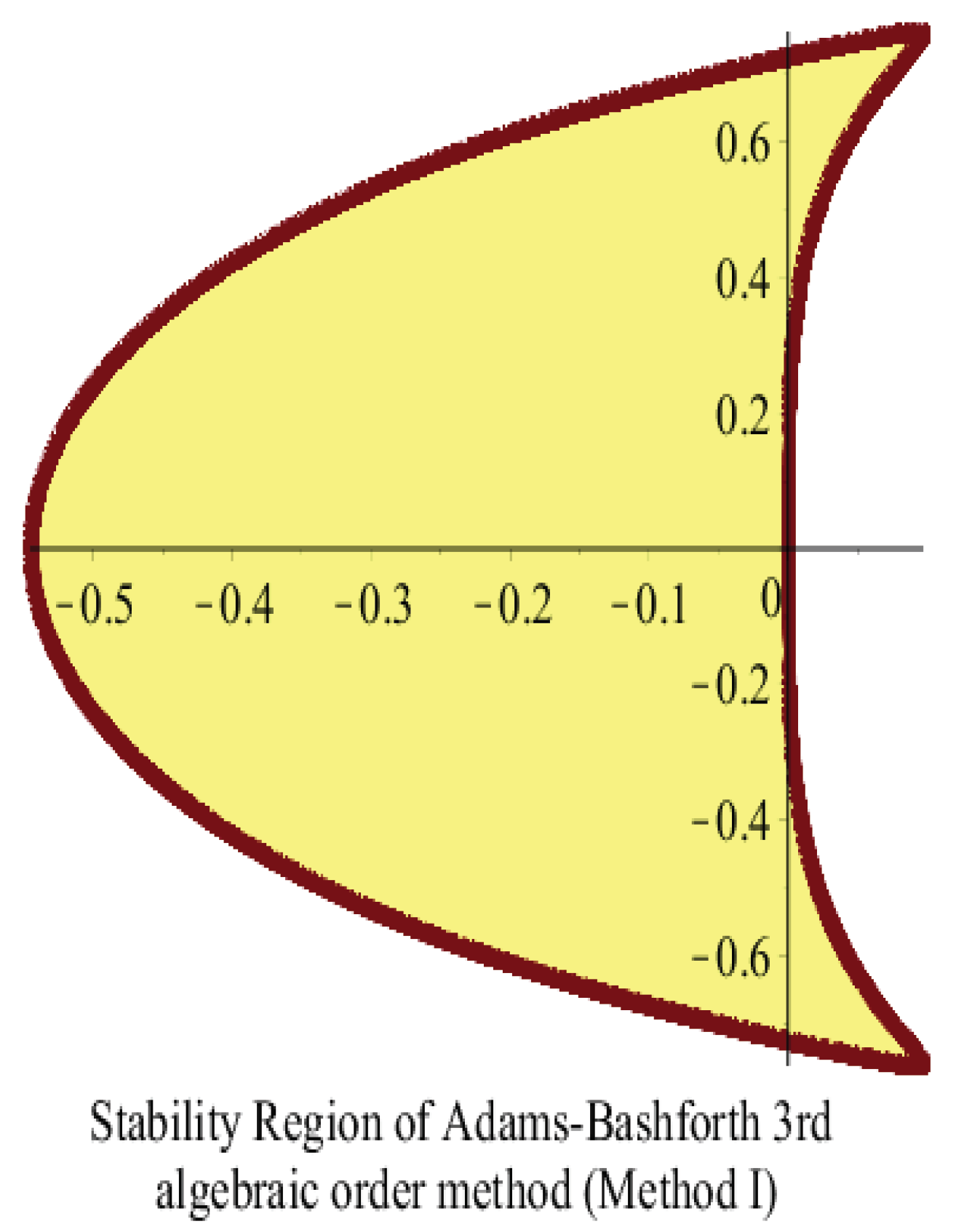
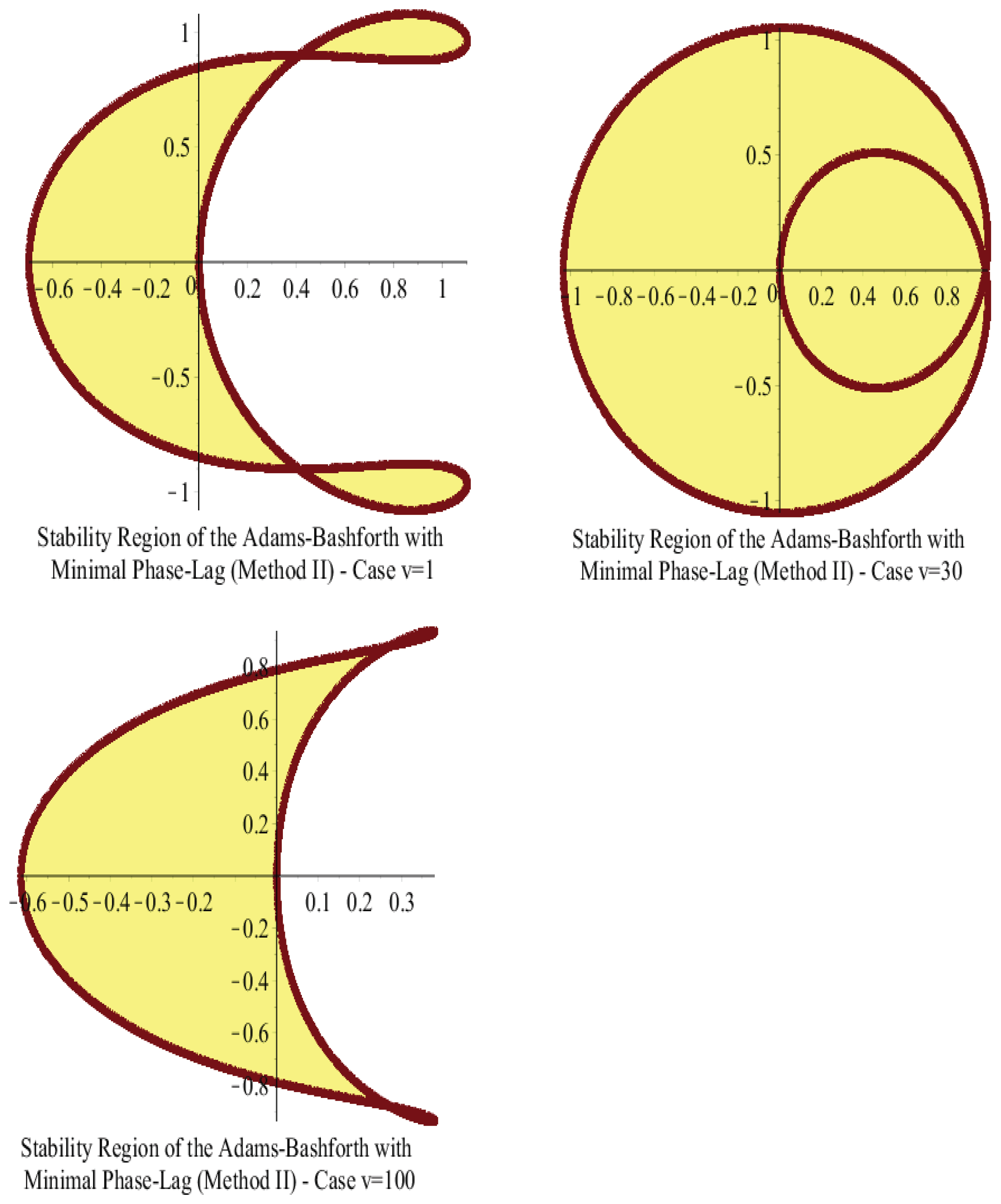
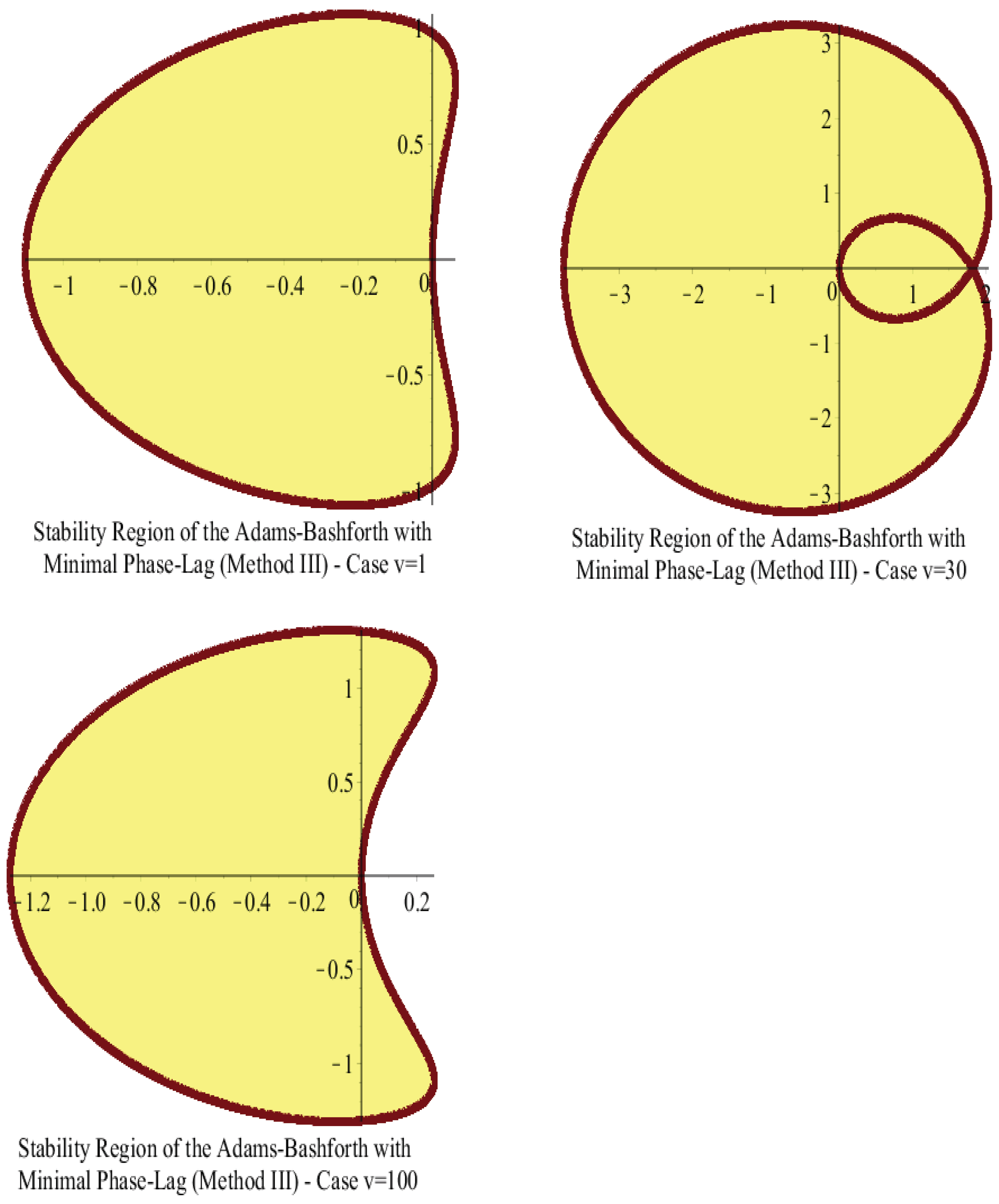
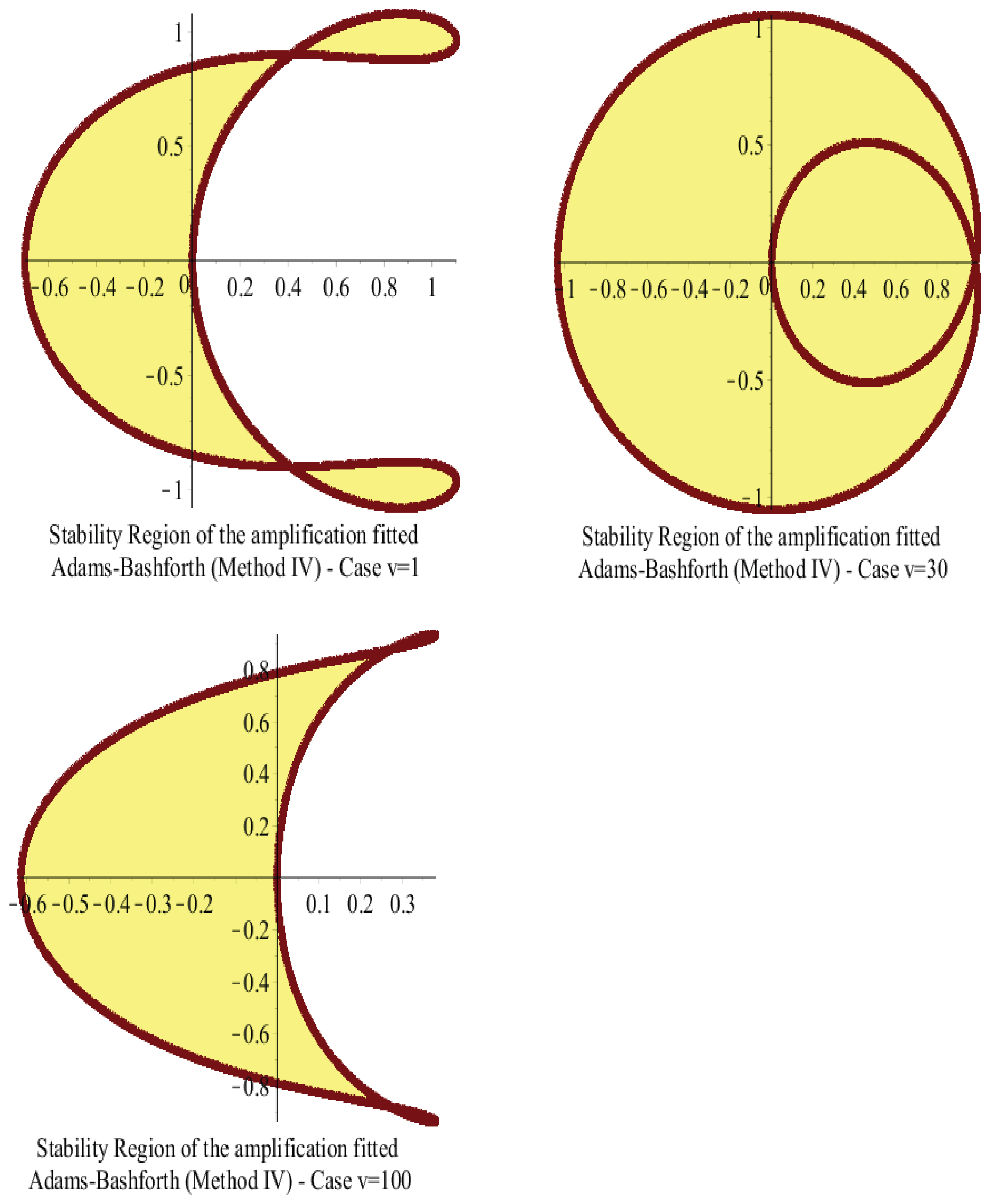
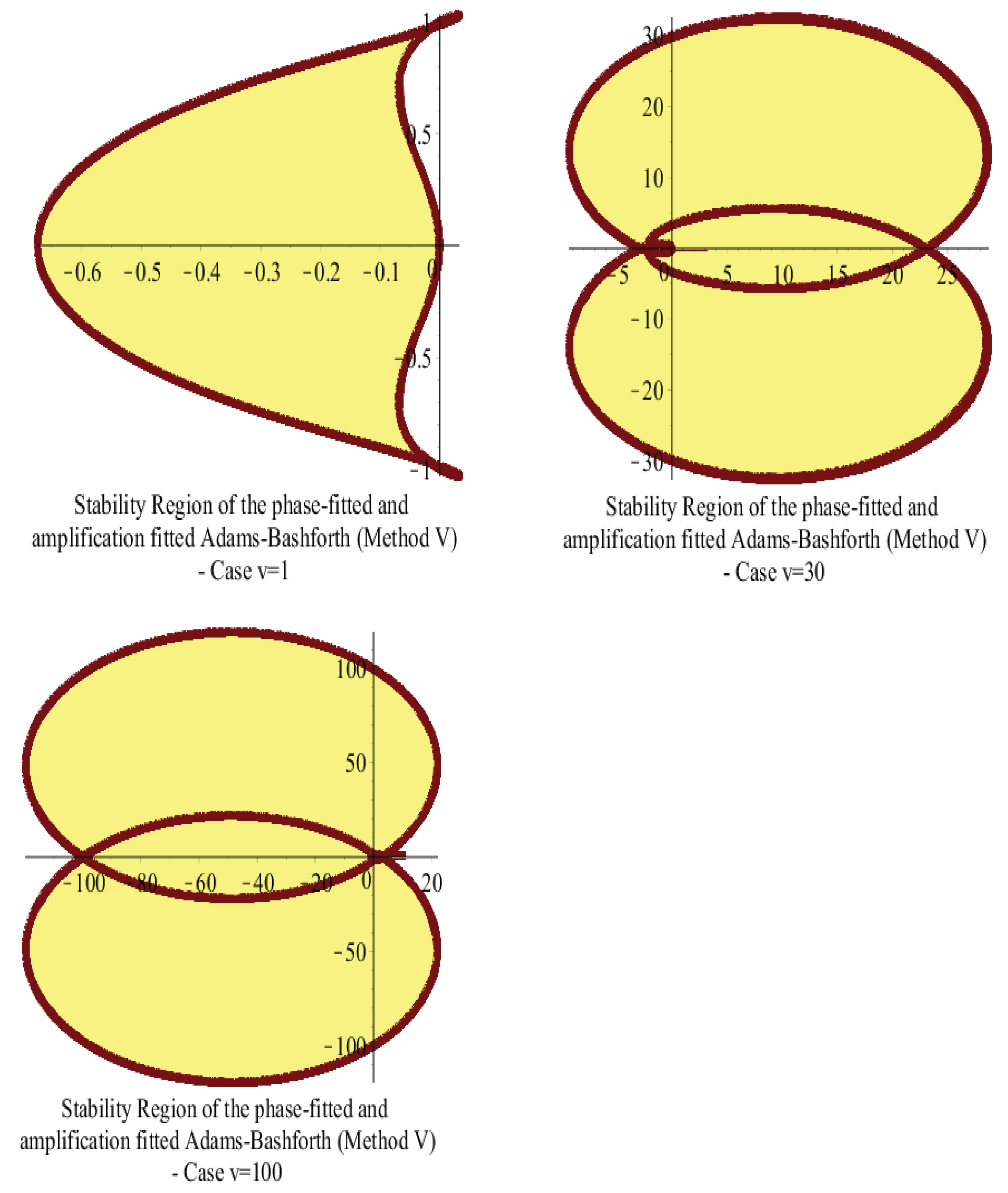
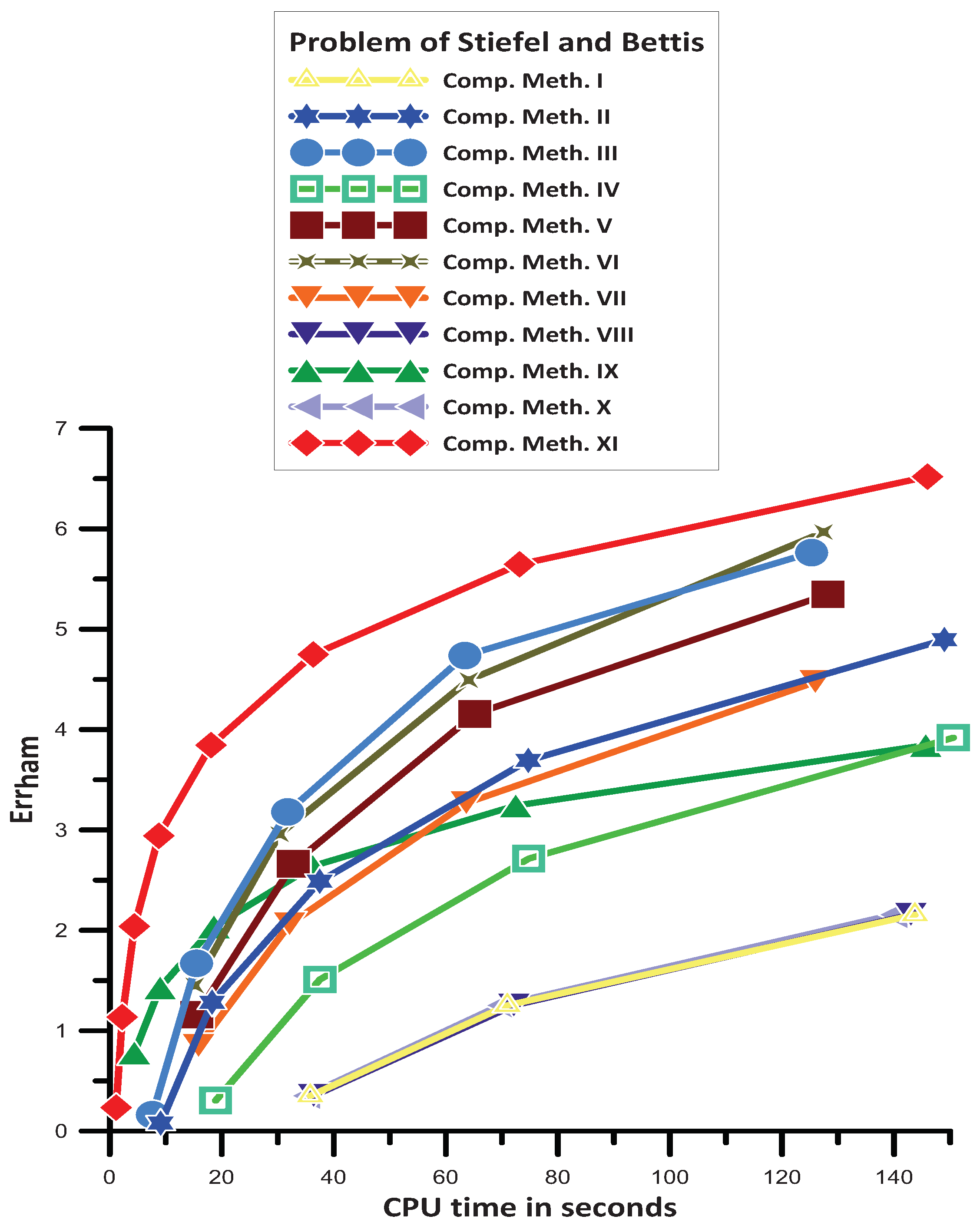
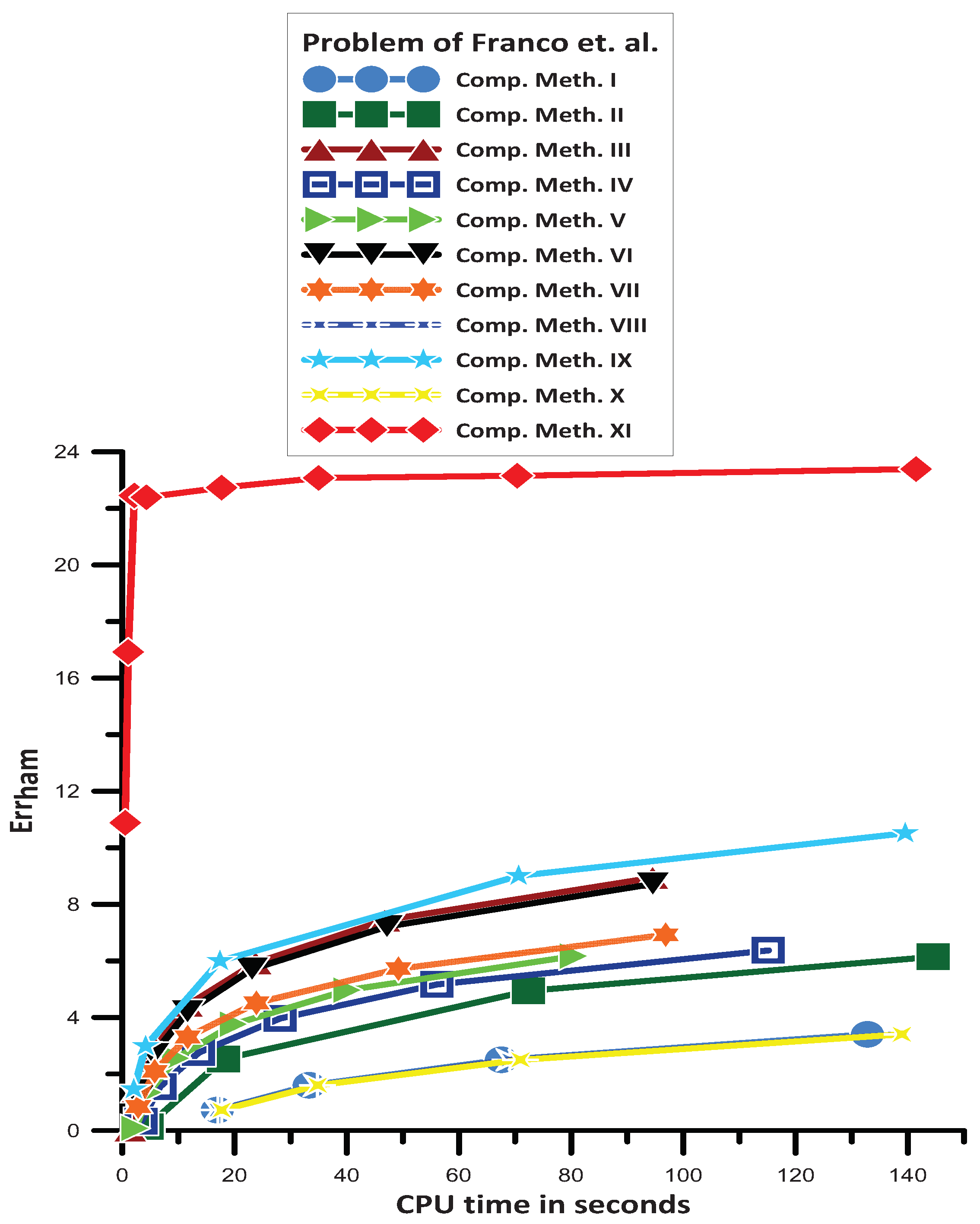
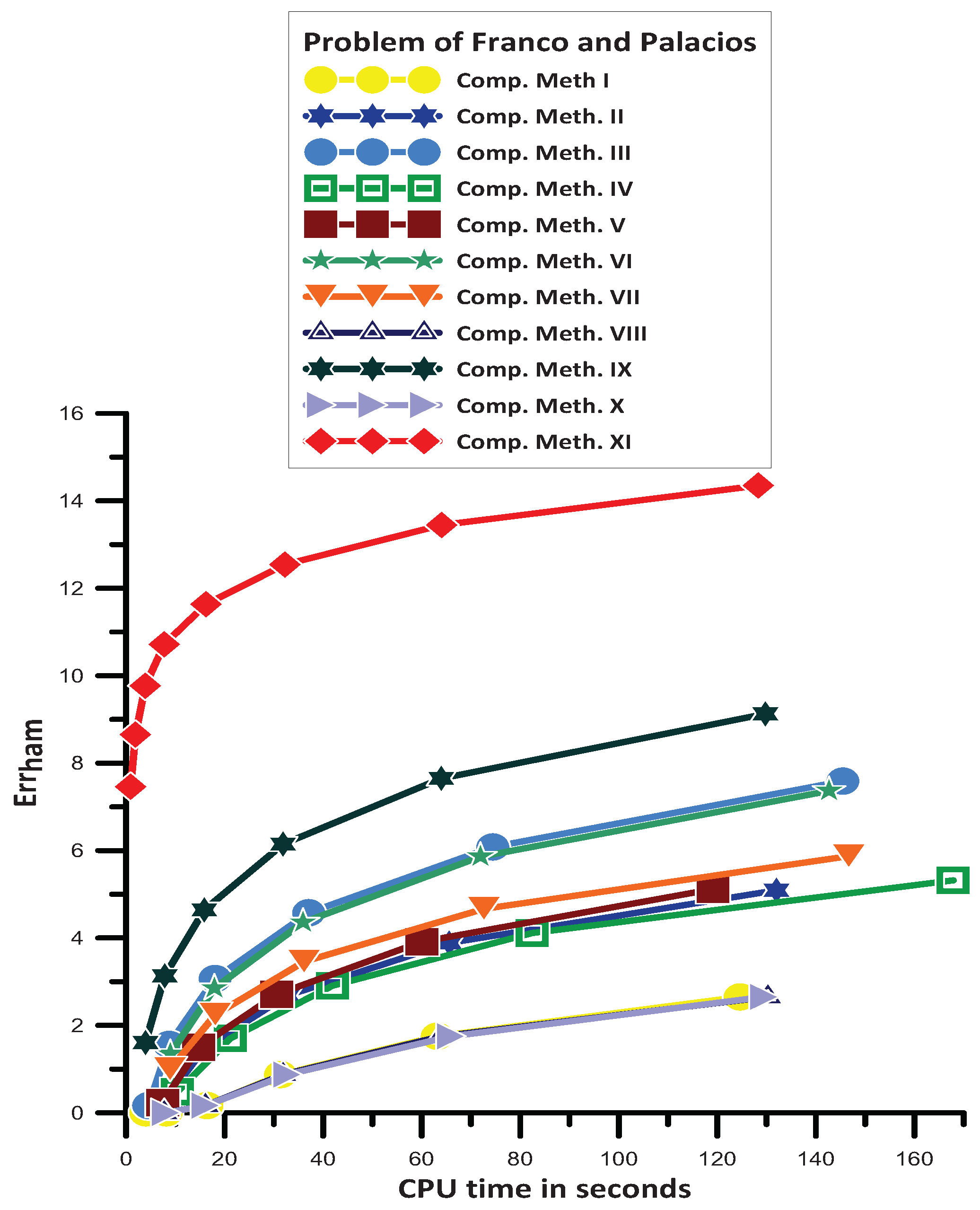
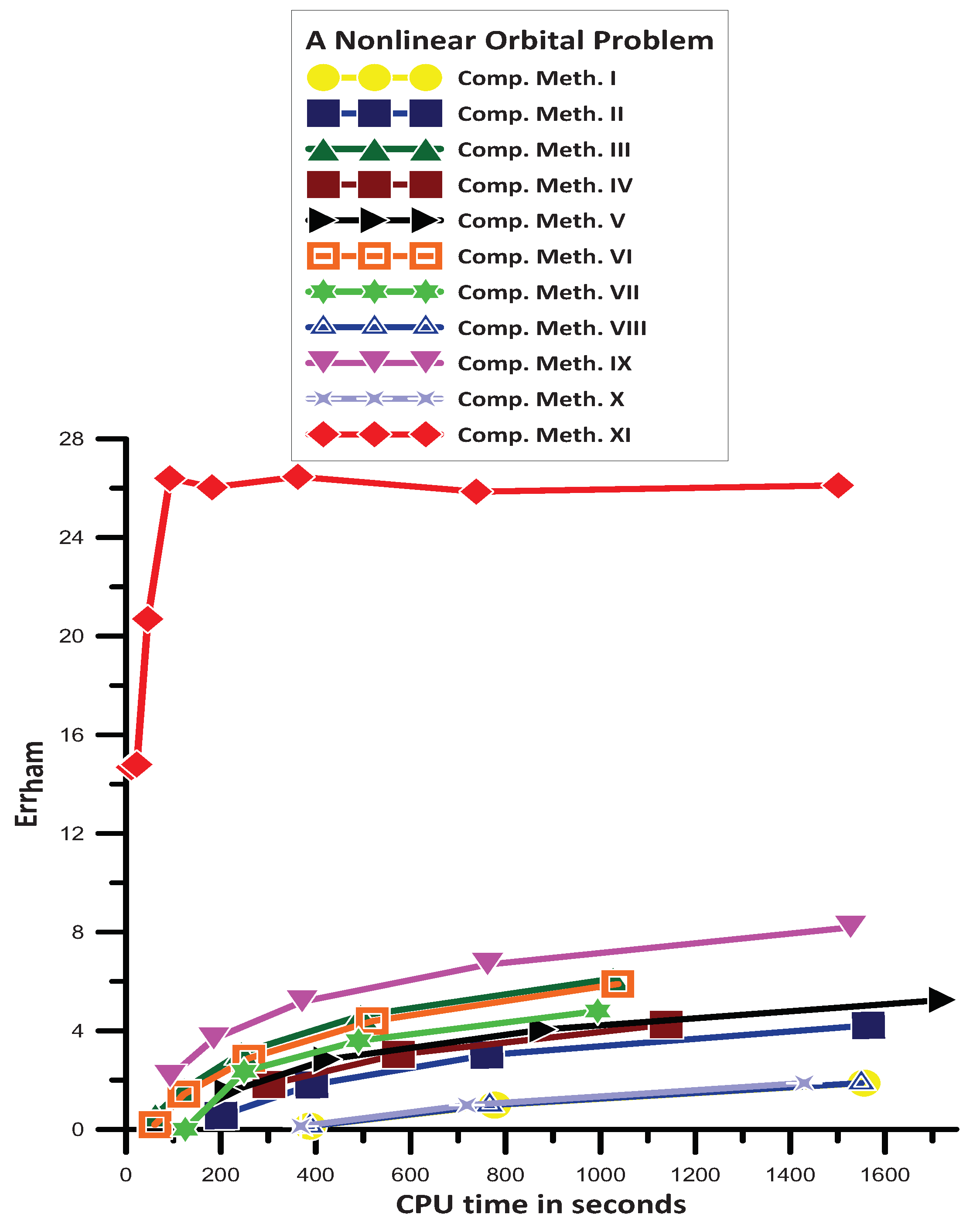
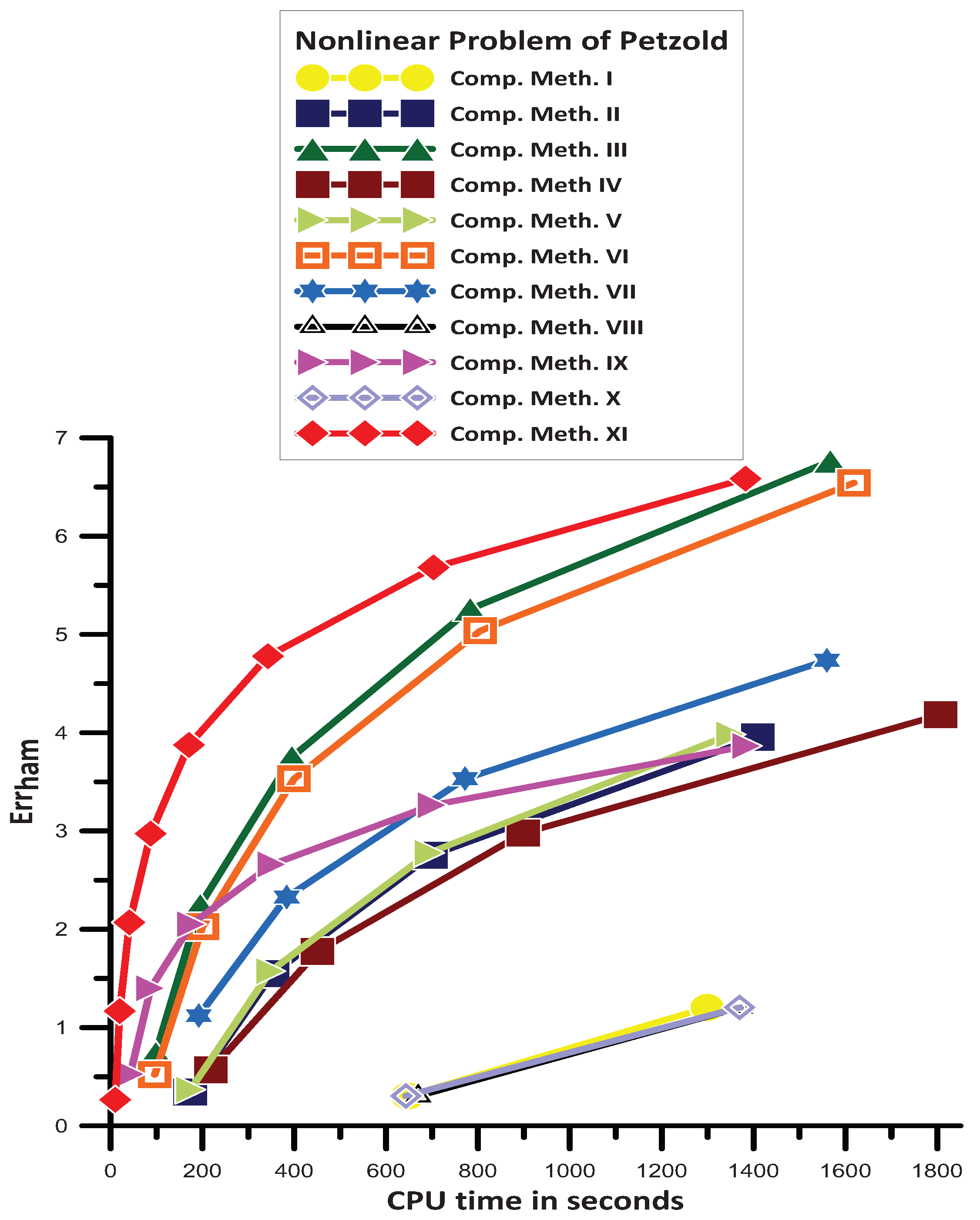

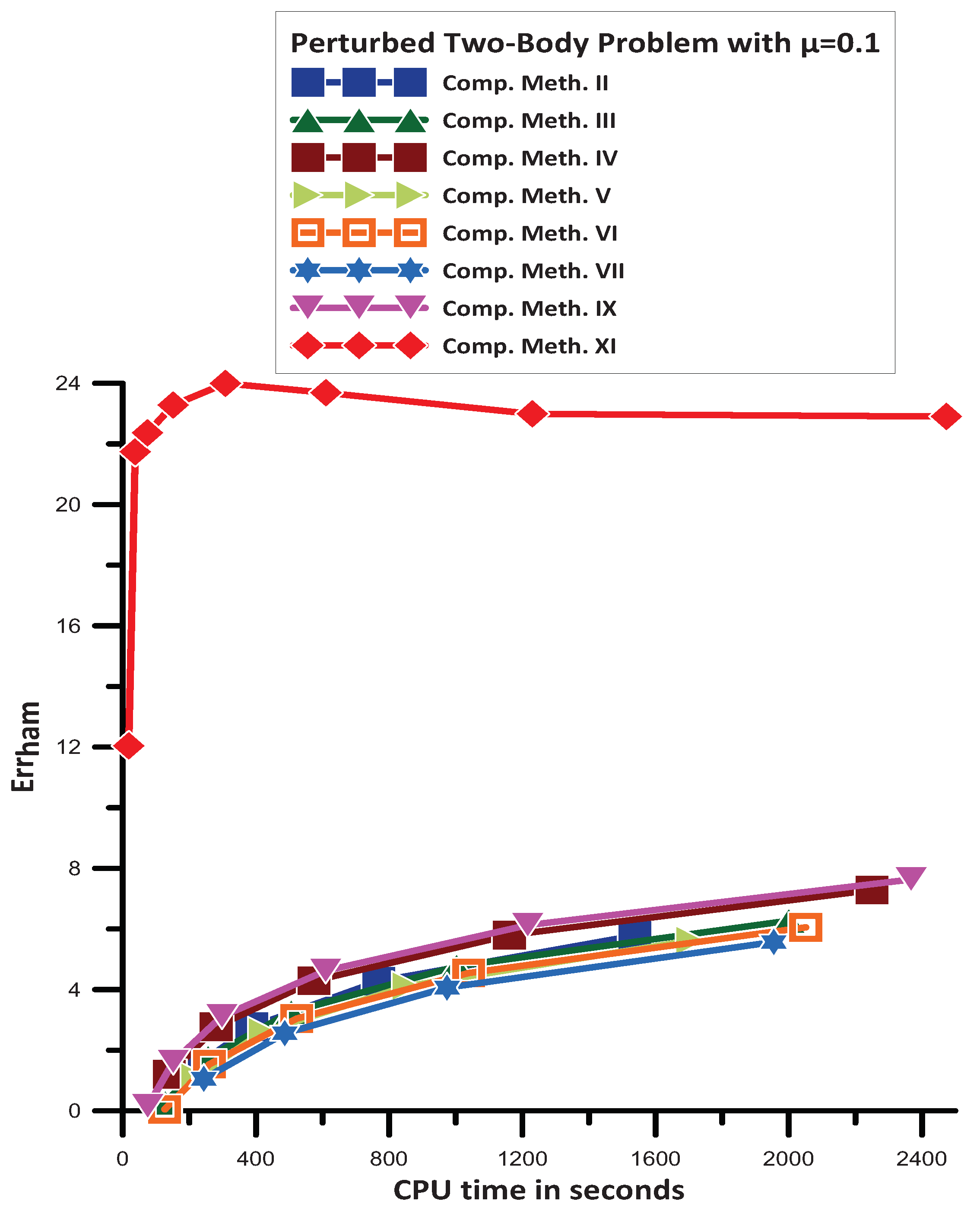
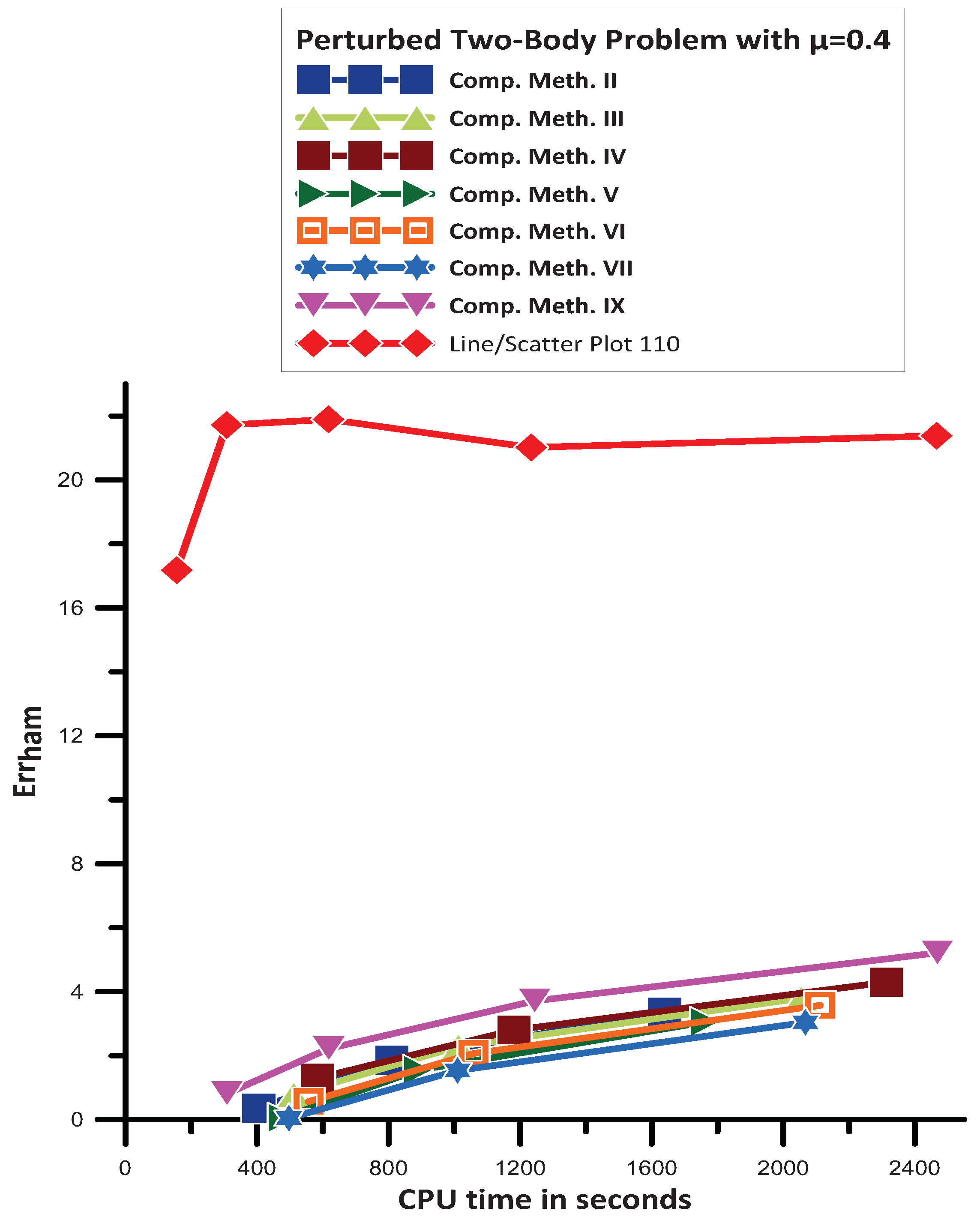
Disclaimer/Publisher’s Note: The statements, opinions and data contained in all publications are solely those of the individual author(s) and contributor(s) and not of MDPI and/or the editor(s). MDPI and/or the editor(s) disclaim responsibility for any injury to people or property resulting from any ideas, methods, instructions or products referred to in the content. |
© 2024 by the author. Licensee MDPI, Basel, Switzerland. This article is an open access article distributed under the terms and conditions of the Creative Commons Attribution (CC BY) license (https://creativecommons.org/licenses/by/4.0/).
Share and Cite
Simos, T.E. A New Methodology for the Development of Efficient Multistep Methods for First-Order IVPs with Oscillating Solutions. Mathematics 2024, 12, 504. https://doi.org/10.3390/math12040504
Simos TE. A New Methodology for the Development of Efficient Multistep Methods for First-Order IVPs with Oscillating Solutions. Mathematics. 2024; 12(4):504. https://doi.org/10.3390/math12040504
Chicago/Turabian StyleSimos, Theodore E. 2024. "A New Methodology for the Development of Efficient Multistep Methods for First-Order IVPs with Oscillating Solutions" Mathematics 12, no. 4: 504. https://doi.org/10.3390/math12040504
APA StyleSimos, T. E. (2024). A New Methodology for the Development of Efficient Multistep Methods for First-Order IVPs with Oscillating Solutions. Mathematics, 12(4), 504. https://doi.org/10.3390/math12040504





